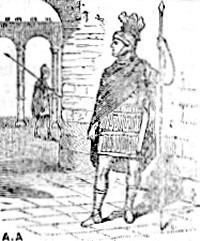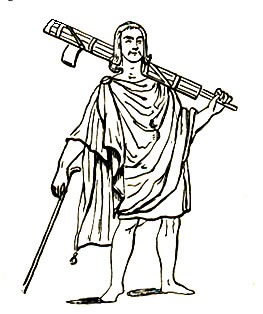SAGUM was the cloak worn by the Roman soldiers and inferior officers, in contradistinction to the Paludamentum of the general and superior officers [Paludamentum.] It is used in opposition to the toga or garb of peace, and we accordingly find that when there was a war in Italy, all citizens put on the sagum even in the city, with the exception of those of consular rank (saga sumere, ad saga ire, in sagis esse, Cic. Phil. VIII.11, V.12, XIV.1): hence in the Social or Marsic war the sagum was worn for two years (Liv. Epit. 72, 73; Vell. Pat. II.16).


The sagum was open in the front, and usually fastened across the shoulders by a clasp, though not always (Trebell. Poll. Tyrann. 10): it resembled in form the Paludamentum (see woodcuts, p854), as we see from the specimens of it on the column of Trajan and other ancient monuments. It was thick and made of wool (Mart. XIV.159), whence the name is sometimes given to the wool itself (Varro, L. L. V.167, ed. Müller). The cloak worn by the general and superior officers is sometimes called sagum (Punicum sagum, Hor. Ep. IX.28), but the diminutive Sagulum is more commonly used in such cases (compare Sil. Ital. IV.519, XVII.528; Liv. XXX.17, XXVII.19).
The cloak worn by the northern nations of Europe is also called sagum: see woodcut, p213, where three Sarmatians are represented with saga, and compare Pallium, p852. The German sagum is mentioned by Tacitus (Germ. 17): that worn by the Gauls seems to have been a species of plaid (versicolor sagulum, Tac. Hist. II.20).
The outer garment worn by slaves and poor persons is also sometimes called sagum (Columell. I.8; compare Dig. 34 tit. 2 s23 § 2).